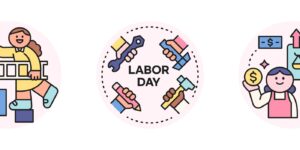

Four Open Doors to Upward Mobility
Pam Sornson, JD
Even without intentional barriers impeding their progress, many people find it challenging to identify the career or occupation they want and then also find a way to achieve it. Often, the family history doesn’t support the aspiration, or family resources aren’t available to meet the financial requirements. Fortunately, society maintains several ways for learners to engage in their chosen work, regardless of their economic background or lack of educational achievement.
Beyond college or university, four alternative avenues to jobs and careers are available to anyone who seeks them: apprenticeships, internships, entrepreneurialism, and union membership. Each entry-level option provides theoretical education and hands-on training for a specific occupation. Once begun, learners can quickly qualify for junior-level positions within the industry of their choice. They can then build on their foundational training over time to master escalating skill and competency levels. In many cases, these non-traditional students can earn more over their lifetime than their four-year university graduate cohorts.

Apprenticeships
In the ‘olden days,’ an apprenticeship was the only way to learn a new trade or occupation. There were no schools to teach hands-on skills, and those schools that existed were focused on more esoteric subjects, such as philosophy or debate. Master artisans took on an apprentice and taught them the skills necessary to provide that service to the community. The expectation was that the apprentice would eventually also become a master and remain in that occupation for life.
The popularity of the apprenticeship as a credentialed training alternative remains high in industries around the world. They are often favored because the qualifications to attain one are usually lower than those needed to qualify for entry into an academic school. A high school diploma, GED, or experience in a related field or occupation is often all it takes to be hired as an apprentice. Further, apprenticeships are usually paid positions, so people aren’t forced to choose between gaining training or earning money. And people who have completed an apprenticeship are also on track to make a solid living over their lifetime. Research indicates that 92% of apprentices who finish their programs and retain their jobs earn an average annual salary of $72,000, giving them the social and economic mobility to rise above their original economic class.

Internships
Like an apprenticeship, an internship offers the opportunity to acquire skills for a specific occupation or trade directly from the tradesperson or business. However, unlike an apprenticeship, which typically lasts one to three years and is usually paid, internships are typically unpaid, last a much shorter period (sometimes just one to three months), and may not lead directly to a full-time job.
Internships still provide educational and occupational value, however. Interns can quickly learn to handle mundane business duties, which relieves the staff from those obligations while helping the intern learn new occupational skills. They may also be tasked with seasonal jobs, short-term contract work, or other short-term functions that respond to company needs while also imparting a valuable educational element to the worker. In many cases, the intern learns more minor aspects of a larger occupational structure that they can build on through future on-the-job training opportunities.
A recent study drew data from 43 million LinkedIn profiles and determined that approximately 13% of all college graduates list at least one internship on their educational transcript.

Entrepreneurialism
Some people find it easier to create their own work than to find it through someone else. The ‘entrepreneur’ is that unique individual who sees a need to be filled and then develops a business to fill it. In some cases, these ‘occupational gaps’ arise when emergencies occur, such as the COVID-19 pandemic. The COVID-19 era shut down many occupations but opened the door to develop many more. The ensuing “remote” economy, populated by entrepreneurs who aggregated skill sets and business assets in direct response to COVID-related demand, has exploded over the past three years, and continues to grow. Many of these new business owners never envisioned themselves as ‘entrepreneurs’ but took advantage of the COVID-driven opportunities to put their skills to better use for their own benefit.
One occupation that became especially valuable through the pandemic – and subsequently generated a whole new community of entrepreneurs – was that of the digital technician. In many cases, the worker recognized that their skill set was more valuable to their companies than those entities knew. As organizations struggled to achieve the ‘remote work’ demands of the day with their (often outdated) digital tools, their sophisticated tech staff resolved those challenges while also building a new business opportunity for themselves. At the same time, the use of ‘artificial intelligence’ (AI) was also on the rise. While many organizations are aware of the value that AI can add to their enterprise, they do not have on staff the digital talent needed to integrate it into their current situation.
As companies adopt more technology, including AI, the remote workforce, and a distributed business model, as examples, the demand for highly skilled digital technicians and software engineers will also rise. As a result, digitally skilled workers may find their brightest future as technology entrepreneurs, filling occupational gaps across virtually all industries.

Union membership
One other route to social mobility is that of union membership. Unions, a group of workers united around ensuring workplace standards are safe and fair, have been around for centuries. Their advocacy for their membership gives them a voice in many corners of the community and allows them to directly influence workplace conditions. Over time, the work of unions has established pay rates, work hours, benefits schedules, and other elements ancillary to the labor performed that would not have been made available without that collective pressure.
Unions have also played an important role in diminishing barriers and providing upward mobility for workers. One older study revealed that unionization resulted in wage raises of over 11% for typical female workers, who also gained access to health insurance and pensions in the process. Further, states with a high union participation rate enjoy a higher overall average wage than those with fewer union members.
Gaining upward mobility – socially, economically, or both – gives workers more opportunities to improve their lives and futures. These four options – apprenticeships, internships, entrepreneurialism, and union memberships – offer all workers, regardless of their original economic class, the opportunity to attain that mobility and move up in their little part of the world.
